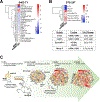WNT5A inhibition alters the malignant peripheral nerve sheath tumor microenvironment and enhances tumor growth
- PMID: 34079083
- PMCID: PMC8217297
- DOI: 10.1038/s41388-021-01773-x
WNT5A inhibition alters the malignant peripheral nerve sheath tumor microenvironment and enhances tumor growth
Abstract
Malignant peripheral nerve sheath tumors (MPNST) are aggressive soft-tissue sarcomas that cause significant mortality in adults with neurofibromatosis type 1. We compared gene expression of growth factors in normal human nerves to MPNST and normal human Schwann cells to MPNST cell lines. We identified WNT5A as the most significantly upregulated ligand-coding gene and verified its protein expression in MPNST cell lines and tumors. In many contexts WNT5A acts as an oncogene. However, inhibiting WNT5A expression using shRNA did not alter MPNST cell proliferation, invasion, migration, or survival in vitro. Rather, shWNT5A-treated MPNST cells upregulated mRNAs associated with the remodeling of extracellular matrix and with immune cell communication. In addition, these cells secreted increased amounts of the proinflammatory cytokines CXCL1, CCL2, IL6, CXCL8, and ICAM1. Versus controls, shWNT5A-expressing MPNST cells formed larger tumors in vivo. Grafted tumors contained elevated macrophage/stromal cells, larger and more numerous blood vessels, and increased levels of Mmp9, Cxcl13, Lipocalin-1, and Ccl12. In some MPNST settings, these effects were mimicked by targeting the WNT5A receptor ROR2. These data suggest that the non-canonical Wnt ligand WNT5A inhibits MPNST tumor formation by modulating the MPNST microenvironment, so that blocking WNT5A accelerates tumor growth in vivo.
Conflict of interest statement
Conflict of Interests
Revolution Medicine and Boehringer-Ingelheim fund some of NR’s research, unrelated to this manuscript. Dr. Largaespada is the co-founder and co-owner of biotechnology companies including NeoClone Biotechnologies, Inc., Discovery Genomics, Inc. (recently acquired by Immunsoft, Inc.), B-MoGen Biotechnologies, Inc. (recently acquired by the biotechne corporation), and Luminary Therapeutics, Inc. He consults for Genentech, Inc., which funds some of his research and holds equity in and serves as the Chief Scientific Officer of Surrogen, a subsidiary of Recombinetics, a genome-editing company. The business of these companies is unrelated to this manuscript.
Figures






References
-
- Evans DG, Howard E, Giblin C, Clancy T, Spencer H, Huson SM, et al. Birth incidence and prevalence of tumor-prone syndromes: estimates from a UK family genetic register service. Am J Med Genet A. 2010;152A(2):327–332. - PubMed
-
- Bos JL, Rehmann H, Wittinghofer A. GEFs and GAPs: critical elements in the control of small G proteins. Cell. 2007;129(5):865–877. - PubMed
Publication types
MeSH terms
Substances
Grants and funding
LinkOut - more resources
Full Text Sources
Research Materials
Miscellaneous

